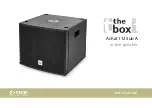
Celan GT 502, 702, 902: at least 20 cm away from the rear wall and at least 30 cm from the side walls.
This will prevent excessive emphasis of the bass range.
Celan GT 302: shelf loudspeakers should also be as free-standing as possible, the distance to the sides
and rear to walls and items should be at least 10 cm, the tweeters should be located at ear height.
You should use the supplied spikes when setting the speakers up. This isolates them from the supporting
surface, preventing unpleasant resonance effects. You can choose between metal and hard rubber spikes
for the standing speakers, while the enclosed hard rubber spikes are used for the shelf speakers. The
spikes are screwed into the threaded bushes on the bottom of the speaker.
The HECO Celan GT loudspeakers are ideal for use with the Celan GT Sub 322A active subwoofer. Fig.
5 shows a method of connection. Please also refer to the subwoofer’s and your amplifier’s operating
instructions.
HECO CELAN GT 302, 502, 702 AND 902 AS A FRONT OR REAR LOUDSPEAKER
The front loudspeakers are positioned at ear height on the left and right as equidistant from the television
as possible. The rear loudspeakers are placed at ear height or a little above on the left and right besides
or better behind the listening position.
Celan GT 302: if possible, the cross-over frequency for the front and rear channels should be adjusted to
approximately 80 Hz in the AV receiver’s set-up.
Otherwise all the recommendations made in the previous chapter also apply.
HECO CELAN GT CENTER 42
The Celan GT Center 42 loudspeaker visually and acoustically ideally matches the other Celan GT
models. The loudspeaker is placed immediately on or under the television set.
Otherwise please adhere to the general recommendations outlined in the previous chapters.
HECO CELAN GT SUB 322A
The Celan GT Sub 322A active subwoofer visually and acoustically ideally matches the other
loudspeakers in the Celan GT series. Please refer to the separate operating instructions supplied with
this product.
CONNECTING TO AN AV RECEIVER
Figs. 6 and 7 show two different methods of connecting to AV receivers.
Fig. 6: AV receiver without subwoofer output.
Fig. 7: AV receiver with subwoofer output.
HOW TO AVOID DAMAGE TO YOUR VALUABLE SPEAKERS
All HECO loudspeakers are designed and built for optimum sound reproduction with the tone controls in
the central position – i.e. with “linear” amplifier output. Turning up the bass and treble controls too far
delivers more power to the woofers and/or tweeters, and at high volumes this can actually destroy the
speaker units!
If the output of your amplifier is significantly higher than the rated power handling capacity of your speakers
extremely high volumes can physically destroy your speakers. This doesn’t actually happen often but you
should be aware that it is possible.
Weak amplifiers with low output ratings can actually be more dangerous for your speakers at medium
volumes because weak amplifiers may overload much faster than powerful ones and this causes
measurable and audible distortion, which is extremely dangerous to your loudspeakers.
Always turn the volume down immediately as soon as you hear distortion! If you like listening to loud music
make sure that your amplifier can deliver at least as much power as the speakers’ power-handling rating.
GB
7








































